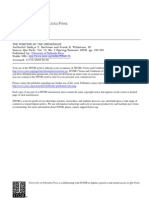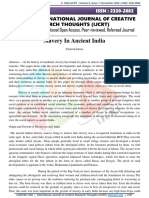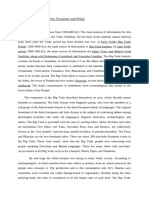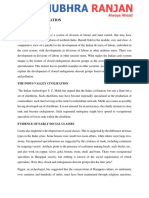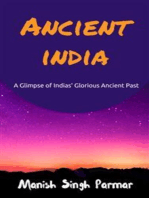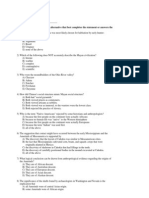Slavery in Ancient India
Slavery in Ancient India
Uploaded by
Rishi RishiCopyright:
Available Formats
Slavery in Ancient India
Slavery in Ancient India
Uploaded by
Rishi RishiCopyright
Available Formats
Share this document
Did you find this document useful?
Is this content inappropriate?
Copyright:
Available Formats
Slavery in Ancient India
Slavery in Ancient India
Uploaded by
Rishi RishiCopyright:
Available Formats
Slavery in Ancient India
References to slaves
The first reference in Rig Vedic text (Rig Veda Samhita onward) of ‘Dasis’ given to sacrificial
priest as a part of ‘Dana’ mentioned in “Dana Stuties” (donation hymns).
The vedic period reference suggest that Dasis were meant for only household purposes.
The post vedic period, we get references of Dasas also i.e. male slaves.
The references of post vedic period onward suggest slaves association with other activities i.e.
beyond confines of the household like agriculture, trade and even army.
This institution continued till in ancient time.
Various categories of slaves
Ancient test mentions various categories of slaves:
Three tripitikas mentions 8 kinds of slaves
Arthashastra mentions 5 kinds of slaves.
Manusmriti mentions 15 kinds of slaves.
Narad Smriti mentions 15 kinds of slaves.
Member of any varna could become slave (even brahmins).
But most of the slaves were sudras.
There were women slaves also but sale and purchase of Brahmin women was banned.
Rights of slaves
The ancient Dharmasastra literature defines the rights of the slaves and the relation with the
masters.
Slaves had right too earn and right to property.
Slaves had right to inherit property.
Slaves had no right to sue and had no right to give evidence (that means their right in law
was almost absent).
Slaves had right to manumission (to become free from slavery).
The right to become free was subject to masters will. In general slaves entering ‘sanyas’
became free.
Masters had no right over life of the slave (master could not kill a slave).
Freedom to slaves
There were various ways through which person become a slave.
By selling oneself in the time of crisis. One could also sell his family.
Prison of war.
One born out of slave parents. (hereditary character).
Slavery in different periods in Ancient India
Slavery during Vedic Age:
Slaves:
There were groups in society who were considered even lower than the Shudras.
Slaves (dasas and dasis) are mentioned among gift items in the dana-stutis.
However, on occasion, children born of slave women could aspire to high status.
The dasas and the dasyus, who were conquered by the Aryans, were treated as slaves
and shudras.
The shudras were meant to serve the three higher varnas and worked as domestic
slaves, agricultural slaves, craftsmen, and hired labourers in post-Vedic times.
Labour and slavery:
The household was the basic unit of labour, and there is no mention of wage labour.
The Rig Veda is, however, familiar with slavery. The Rig Veda refers to enslavement in
the course of war or as a result of debt.
The fact that in later times, dasa and dasi are terms used for male and female slaves,
suggests that initially, ethnic differences may have been an important basis of
enslavement.
Slaves, male and female, generally worked in the household, but were not used to any
significant extent in production-related activities.
Slaves were not used directly in agriculture or other productive activities. We find
domestic slaves but not wage-earners.
We repeatedly hear of slaves who were given as gifts to the priests. These were
primarily women employed for domestic purposes.
Princes and priests employed women slaves for domestic service, but their
number were probably not large.
Throughout history, there was an important difference in the experience of
enslavement for men and women—for women, enslavement generally involved sexual
exploitation in addition to exploitation of their labour.
Gifts of slaves:
Hymns in praise of gifts (dana-stutis) in the later books of the Rig Veda refer to
generous presents of cows, horses, chariots, gold, clothes, and female slaves made by
kings to priests.
Slavery during NBPW period:
The new techniques and the use of force enabled some people to own large stretches of
land which needed a substantial number of slaves and hired labourers to till it.
In Vedic times, people cultivated their fields with the assistance of family members
only; there is no word for wage-earner in Vedic literature.
However, slaves and wage-earners engaged in cultivation became a regular feature in
the age of the Buddha. Hence, during NBPW, large plots of land worked with the help
of slaves and agricultural labourers.
The texts of 600-300 BCE period contain many references to the existence of male and
female slaves:
The Digha Nikaya states that a dasa is not master of himself, depends on another, and
cannot go where he likes.
The Vinaya Pitaka speaks of three kinds of slaves—the antojatako, dhanakkito, and
karamaraanito.
The antojatako seems to refer to the offspring of a woman slave.
A slave who is bought is known as dhanakkito.
One brought from another country and enslaved is the karamaraanito.
The Digha Nikaya mentions a fourth type of slave—samam dasavayam upagato,
one who has himself accepted enslavement.
There are a few references to the manumission of slaves.
In fact one of the rules of the Buddhist sangha was that slaves could not join until
and unless they were freed by their masters.
Given the elitist bias of the literary sources, it is not easy to reconstruct the ways in
which groups such as the Chandalas and slaves may have reacted to their
subordination and oppression.
Chakravarti has identified two instances of resistance in the Buddhist canon.
One is a reference in the Vinaya Pitaka to the dasa-kammakaras of the Sakyas
attacking the womenfolk of their masters in the woods as an act of
vengeance.
The second is the story of the dasi Kali and her mistress, the gahapatni
Vaidehi, in the Majjhima Nikaya.
Kali was submissive and hard-working, and came to the conclusion that
her mistress’ even temper was the result of her own exemplary conduct.
She decided to subject Vaidehi to a test. She started waking up late and
did not respond to her mistress’ calls three days in a row.
Vaidehi couldn’t take it. She got more and more angry and finally
attacked Kali in fury. Kali was proved right.
Slavery during Mauryan period:
Megasthenes states that he did not notice any slaves in India, but there is little doubt that
there had been domestic slaves from Vedic times onwards.
The Arthashastra, on the other hand, has a very detailed discussion of dasas (slaves) and
ahitakas (those pledged to creditors when contracting a debt).
Various types of slaves and situations of enslavement temporary and permanent, are
mentioned.
The Arthashastra mentions village labour, bonded labour and slave labour.
There is reference to slaves in the service of private individuals as well as the state.
Kautilya lists various rules for the treatment of male and female slaves and lays
down penalties for their transgression.
e.g: punishments are prescribed for those who sell or mortgage a pregnant
woman slave without any arrangement for her maternity, and for those who
cause such a slave to have a miscarriage.
There is reference to the manumission (freeing) of slaves on payment of a sum of
money.
Kautilya also states that if a dasi bore her master a son, she was released from
enslavement, and the child was considered the father’s legitimate son.
According to the Arthashastra of Kautilya, a striking social development of the Maurya
period was the employment of slaves in agricultural operations.
During the Maurya period slaves were engaged in agricultural work on a large scale.
The Arthashastra of Kautilya shows that during the Maurya period they worked on
large state farms.
The state maintained farms on which numerous slaves and hired labourers were
employed.
About 150,000 war-captives brought by Ashoka from Kalinga to Pataliputra may have
been engaged in agriculture, but the number of 1,50,000 seems to be exaggerated.
However, by and large, slaves in ancient India were meant to undertake domestic
work. Generally the small peasant, occasionally aided by slaves and hired labourers,
played the dominant role in production.
Ashoka’s Rock edict:
Ashoka’s rock edict 9 mentions courteous behaviour towards dasas and bhatakas
(bhritakas, i.e., servants) as part of dhamma.
In Rock edict 9, Ashoka describes ceremony of dhamma as consisting in proper
courtesy to slaves and servants, respectful behaviour towards elders,
restraint in one’s dealings with all living beings, and liberality to shramanas
and Brahmanas.
Rock edict 11 refers to the gift of dhamma being the best of all gifts. It is said to
include proper courtesy to slaves and servants.
Buddhist texts:
they refer to dasas, dasis, kammakaras, and porisas working in households and on
land.
The words dasa and dasi for male and female slaves are known in earlier sources. But
kammakara is new and refers to someone who hired out his labour in return for
wages.
In post-Maurya times in the republics of the Malavas and the Kshudrakas, the kshatriyas and
the brahmanas were given citizenship, but slaves and hired labourers were excluded from it.
Slavery during Sangam Age:
The Sangam texts speak of the Yavanas coming in their own vessels, purchasing pepper
with gold, and supplying wine and women slaves to the natives.
Agricultural operations were generally the task of members of the lowest class (kadaisiyar),
whose status appears to have differed little from that of slave.
In the second century AD, famous Chola king Karikala constructed 160 km of embankment
along the Kaveri river. This was built with the labour of 12,000 slaves who were brought as
captives from Sri Lanka.
Slavery during 300-600 CE:
Forced labour (vishti) became more common than before in 300-600 CE period.
The fact that it is mentioned along with taxes in land grant inscriptions suggests that it was
considered a source of income for the state, a sort of tax payed by the people.
The fact that most of the inscriptions referring to vishti come from the Madhya Pradesh and
Kathiawar regions may suggest that this practice was more prevalent in these areas.
The Narada Smriti has a detailed discussion of slavery and lists 15 types of slaves.
This enumeration is greater than that in the Arthashastra and Manu Smriti, but
basically consists of elaborations or sub-divisions of already known types. These
include
war captives reduced to slavery,
debt enslavement, and
voluntary enslavement.
Slave as property:
Slaves could be handed down to descendants of their erstwhile owners along with
other items of property.
Slaves are generally mentioned as domestic servants or personal attendants.
A child born of a woman slave in a master’s house was considered his slave as well.
The Narada Smriti asserts that a slave can be pledged or mortgaged, and that the
master could hire out his services to another.
The Narada Smriti prescribes the amputation of the foot of a person found guilty of
abducting a slave woman.
Manumission of slaves:
The Narada Smriti discusses the manumission of slaves—a slave born in the house,
bought, obtained, or inherited could be freed only when the master desired to do so.
The ceremony of manumission is described—the master was supposed to remove a jar
of water from the shoulder of the slave and break it. He was then supposed to sprinkle
some parched grain and flowers over his head and say three times: ‘You are no longer
a dasa.’
However, ancient Indian society was not a slave society. The tasks that slaves performed in Greece
and Rome were undertaken by the shudras in India. The shudras were regarded as the collective
property of the three higher varnas. They were compelled to serve them as slaves, artisans,
agricultural labourers, and domestic servants.
Unlike Roman society, ancient Indian society did not employ slaves in production on any scale. In
India, the principal burden of production and taxation fell on the peasants, artisans, merchants, and
agricultural labourers, who were placed in the categories of vaishyas and shudras.
You might also like
- Download Full (Solution Manual) Principles of Operations Management Sustainability and Supply Chain Management 10th PDF All ChaptersDocument34 pagesDownload Full (Solution Manual) Principles of Operations Management Sustainability and Supply Chain Management 10th PDF All ChaptersbevinboberqvNo ratings yet
- Lesson 5 Freedom of The Human PersonDocument23 pagesLesson 5 Freedom of The Human PersonRovie Perps Nopre Andes100% (4)
- History of Prostitution in India 11111Document2 pagesHistory of Prostitution in India 11111Ankit AnandNo ratings yet
- Publication NavrongoDocument40 pagesPublication NavrongoKwamivi Zewuze AdzrakuNo ratings yet
- Age of Empires - The Rise of Rome - Manual - PCDocument35 pagesAge of Empires - The Rise of Rome - Manual - PCCharles Arnesus100% (1)
- Hartman Wilderson - Position of The UnthoughtDocument20 pagesHartman Wilderson - Position of The Unthoughtjamesbliss0100% (3)
- Slavery in Ancient IndiaDocument6 pagesSlavery in Ancient IndiaYashitaNo ratings yet
- IJCRT2011448Document6 pagesIJCRT2011448shinyNo ratings yet
- Human Sacrifice in Colonial Central India: Myth, Agency and Representation by Crispin BatesDocument30 pagesHuman Sacrifice in Colonial Central India: Myth, Agency and Representation by Crispin BatesCrispin BatesNo ratings yet
- Women Prostitutes and Prostitution in Ancient IndiaDocument11 pagesWomen Prostitutes and Prostitution in Ancient Indiarudrakshi raiNo ratings yet
- 2006 BatesDocument31 pages2006 BatesRaman OadNo ratings yet
- Varna, Jatis and RemarriageDocument5 pagesVarna, Jatis and RemarriagesmrithiNo ratings yet
- Gupta Society EssayDocument5 pagesGupta Society EssaySiddharth BhanushaliNo ratings yet
- Ancient Indain Devadasis PDFDocument15 pagesAncient Indain Devadasis PDFVridhachalam Ramakrishnan KolanjinathanNo ratings yet
- 08 - Chapter 3 PDFDocument29 pages08 - Chapter 3 PDFhemanthNo ratings yet
- Indian Social Structure: Module - 8Document15 pagesIndian Social Structure: Module - 8madhugangulaNo ratings yet
- Vedic Age (1500-600bc) : Present Name Ancient Name Indus Jhelum Chenab Beas Raavi Sutlej SaraswatiDocument8 pagesVedic Age (1500-600bc) : Present Name Ancient Name Indus Jhelum Chenab Beas Raavi Sutlej SaraswatiDinesh KattaNo ratings yet
- INDIAN SOCIETY Unit 1 To 4 Complete Note PDFDocument18 pagesINDIAN SOCIETY Unit 1 To 4 Complete Note PDFSSP_Biki86% (14)
- Women of Ancient IndiaDocument58 pagesWomen of Ancient IndiaLeonardo da CapriNo ratings yet
- Role of Women in The Brahmanas PDFDocument58 pagesRole of Women in The Brahmanas PDFDr. Sashibhusan MishraNo ratings yet
- History Handout 2Document31 pagesHistory Handout 2Gagandeep KumarNo ratings yet
- Society and Economy of Early IndiaDocument4 pagesSociety and Economy of Early IndiaIshani MukherjeeNo ratings yet
- Revolution and Counter-Revolution in Ancient India - Dr. B.R.ambedkarDocument244 pagesRevolution and Counter-Revolution in Ancient India - Dr. B.R.ambedkarVeeramani Mani100% (1)
- Kinship, caste and classDocument4 pagesKinship, caste and classkovid sharmaNo ratings yet
- Microsoft Word - Revolution and Counter Revolution in Ancient India - Docx - B R AmbedkarDocument186 pagesMicrosoft Word - Revolution and Counter Revolution in Ancient India - Docx - B R AmbedkarburiedcriesNo ratings yet
- Book-1 QaDocument32 pagesBook-1 Qavikashkumarchoudhary8581No ratings yet
- Ancient History Class 2Document6 pagesAncient History Class 2omkarmothukuriNo ratings yet
- Legal HistoryDocument5 pagesLegal HistoryGaurav singhNo ratings yet
- Early Medieval - KalhanaDocument5 pagesEarly Medieval - KalhanaAvantika YadavNo ratings yet
- A Note On Caste SystemkDocument6 pagesA Note On Caste Systemkgoldspotter9841No ratings yet
- GuptaDocument13 pagesGuptaavinash_formalNo ratings yet
- CC5 Mod 3CDocument7 pagesCC5 Mod 3CAparupa RoyNo ratings yet
- 17.12.2020 Sangam SocietyDocument18 pages17.12.2020 Sangam SocietyRavi SankaranNo ratings yet
- Oswaal CBSE Class 12 History Revision Notes Chapter-3Document5 pagesOswaal CBSE Class 12 History Revision Notes Chapter-3Riti KhandujaNo ratings yet
- Chapter - Xii Society, Religion and Temple: /j-U-V-/J-U-V-/J-u-u-u-u-u-u-u-U-U-U-u-U-U-VJ-VJ-U-U-U-U-U-U-U-VJDocument35 pagesChapter - Xii Society, Religion and Temple: /j-U-V-/J-U-V-/J-u-u-u-u-u-u-u-U-U-U-u-U-U-VJ-VJ-U-U-U-U-U-U-U-VJZarbEChishtiNo ratings yet
- Class 12 History Notes Chapter 3 KinshipDocument5 pagesClass 12 History Notes Chapter 3 KinshipAhsas 6080No ratings yet
- Aryan CivilisationDocument22 pagesAryan CivilisationAlston FernandesNo ratings yet
- CoKuP3AmS592 ‘Sati’ an Inhuman Custom in Medieval Tamil SocietyDocument7 pagesCoKuP3AmS592 ‘Sati’ an Inhuman Custom in Medieval Tamil SocietyMeghaNo ratings yet
- Guilds of Ancient IndiaDocument5 pagesGuilds of Ancient Indiabidyut_majumder_3No ratings yet
- Rise of Rajputas and Nature PDFDocument14 pagesRise of Rajputas and Nature PDFAnkus GhoshNo ratings yet
- Status of WomenDocument63 pagesStatus of WomenSHIVANSHI SHUKLANo ratings yet
- Notes On Chapter 3Document8 pagesNotes On Chapter 3Smita ChandraNo ratings yet
- Position of WomenDocument3 pagesPosition of WomenZubair AnsariNo ratings yet
- Women Slaves in Medieval IndiaDocument11 pagesWomen Slaves in Medieval IndiaŽubori PotokNo ratings yet
- Position of Common Women'S Under The Imperial Cholas: Vol. 3 No. 3 January 2016 ISSN: 2321 - 788XDocument6 pagesPosition of Common Women'S Under The Imperial Cholas: Vol. 3 No. 3 January 2016 ISSN: 2321 - 788Xcoldstone39908No ratings yet
- Verrier Elwin, Sarat Chandra Roy - The Agaria (1992, Oxford University Press, USA)Document383 pagesVerrier Elwin, Sarat Chandra Roy - The Agaria (1992, Oxford University Press, USA)ravibaswaniNo ratings yet
- Rig Vedic Period NotesDocument5 pagesRig Vedic Period NotesKunalNo ratings yet
- Unit 11 15 PDFDocument84 pagesUnit 11 15 PDF45satishNo ratings yet
- Constitutional History Article ReviewDocument10 pagesConstitutional History Article Reviewkarmanyag240No ratings yet
- Position of Women in Kerala in 1956Document32 pagesPosition of Women in Kerala in 1956Siddalingappa SidramaNo ratings yet
- The Three Principal Organs of Rig Vedic PolityDocument9 pagesThe Three Principal Organs of Rig Vedic PolityLauncelot SpaderNo ratings yet
- Post GuptasDocument8 pagesPost GuptasMiya ThomasNo ratings yet
- Social Life: The Brahmanical OrderDocument14 pagesSocial Life: The Brahmanical OrderAnjana SinghNo ratings yet
- Early Vedic: The Aryan ProblemDocument8 pagesEarly Vedic: The Aryan ProblemKhizar MansooriNo ratings yet
- Kinship Caste and Class 12Document5 pagesKinship Caste and Class 12subhabratapaul23No ratings yet
- Guilds in Ancient IndiaDocument12 pagesGuilds in Ancient IndiaAnonymous LsyWN2oJ100% (1)
- Worksheet4 Later Vedic Period 1709116692877Document15 pagesWorksheet4 Later Vedic Period 1709116692877Pavan KalyanNo ratings yet
- Caste SystemDocument34 pagesCaste SystemUpsc StudyNo ratings yet
- The Writer's Class of Ancient India - A Study in Social MobilityDocument14 pagesThe Writer's Class of Ancient India - A Study in Social MobilityNishant SinghNo ratings yet
- Kinship, Caste and ClassDocument25 pagesKinship, Caste and ClassDiya GargNo ratings yet
- Grade 6 GSDocument84 pagesGrade 6 GSNithish BalasubramoniamNo ratings yet
- Later Vedic Period ImppDocument11 pagesLater Vedic Period Imppsurya kantNo ratings yet
- The Tribes and Castes of the Central Provinces of India, Book IVFrom EverandThe Tribes and Castes of the Central Provinces of India, Book IVNo ratings yet
- Ancient India: A Glimpse of Indias' Glorious Ancient PastFrom EverandAncient India: A Glimpse of Indias' Glorious Ancient PastNo ratings yet
- Carnival LondonDocument19 pagesCarnival LondonCristian MundacaNo ratings yet
- The Narrative of Frederick DouglassDocument34 pagesThe Narrative of Frederick DouglassYashrajNo ratings yet
- The Philippine Century HenceDocument1 pageThe Philippine Century HenceAyaBasilioNo ratings yet
- CandideDocument15 pagesCandideTatiana CaramanNo ratings yet
- Jefferson 0054-01 EBk v6.0Document260 pagesJefferson 0054-01 EBk v6.0Esteban ZapataNo ratings yet
- Disagreement Politics and Philosophy PDFDocument78 pagesDisagreement Politics and Philosophy PDFPaul StraitNo ratings yet
- A Phonological Analysis of Black English in 50 Cent'S Song Lyrics in The Album Curtis'Document83 pagesA Phonological Analysis of Black English in 50 Cent'S Song Lyrics in The Album Curtis'Nadya BerlianNo ratings yet
- APUSH Chapter 16 NotesDocument5 pagesAPUSH Chapter 16 NotesphthysyllysmNo ratings yet
- Tudor, English and Black - and Not A Slave in SightDocument5 pagesTudor, English and Black - and Not A Slave in SightAnonymous HZYezh1y3QNo ratings yet
- ASRC 2602 TURNER Drawing The Color Line ZINNDocument11 pagesASRC 2602 TURNER Drawing The Color Line ZINNPPASJANo ratings yet
- The Governor Porcena and GabiusDocument680 pagesThe Governor Porcena and GabiuslifeinthemixNo ratings yet
- A Curriculum Guide To Teaching and Discussing: Blues People: Negro Music in White America (1963) by Leroi JonesDocument13 pagesA Curriculum Guide To Teaching and Discussing: Blues People: Negro Music in White America (1963) by Leroi JonesReginaNo ratings yet
- Chapter 1 Awareness On Mendicancy LawDocument12 pagesChapter 1 Awareness On Mendicancy LawRonnJosephdelRioNo ratings yet
- Caste Systems in AfricaDocument24 pagesCaste Systems in AfricaAnonymous hcACjq8No ratings yet
- 50 Facts That Should Change The WorldDocument8 pages50 Facts That Should Change The WorldAgnieszka KomorowskaNo ratings yet
- ADELMAN, Jeremy. (2008) An Age of Imperial RevolutionsDocument24 pagesADELMAN, Jeremy. (2008) An Age of Imperial RevolutionsFelipe Alfonso100% (1)
- The Barbados RevoltDocument3 pagesThe Barbados Revoltserraj67% (3)
- Memoirs of A Monticello SlaveDocument103 pagesMemoirs of A Monticello SlaveMLSBU11No ratings yet
- MULTIPLE CHOICE. Choose The One Alternative That Best Completes The Statement or Answers TheDocument12 pagesMULTIPLE CHOICE. Choose The One Alternative That Best Completes The Statement or Answers Themad05963No ratings yet
- TH Problem of Evil in Heart of Darkness: EvilsDocument4 pagesTH Problem of Evil in Heart of Darkness: EvilsmostarjelicaNo ratings yet
- Julius Caesar Study Guide PDFDocument9 pagesJulius Caesar Study Guide PDFPriscilla Greaves100% (2)
- Book History Patton U of U - History - The Murder of General PattonDocument5 pagesBook History Patton U of U - History - The Murder of General PattonKevin CareyNo ratings yet
- Emancipation and ApprenticeshipDocument2 pagesEmancipation and ApprenticeshipBlitz Gaming654No ratings yet
- Radical ReconstructionDocument12 pagesRadical ReconstructionMiss SwetlanaNo ratings yet
- Naming A New Self: Identity Elasticity and Self-Definition in Voluntary Name ChangesDocument11 pagesNaming A New Self: Identity Elasticity and Self-Definition in Voluntary Name ChangesakshayppNo ratings yet





